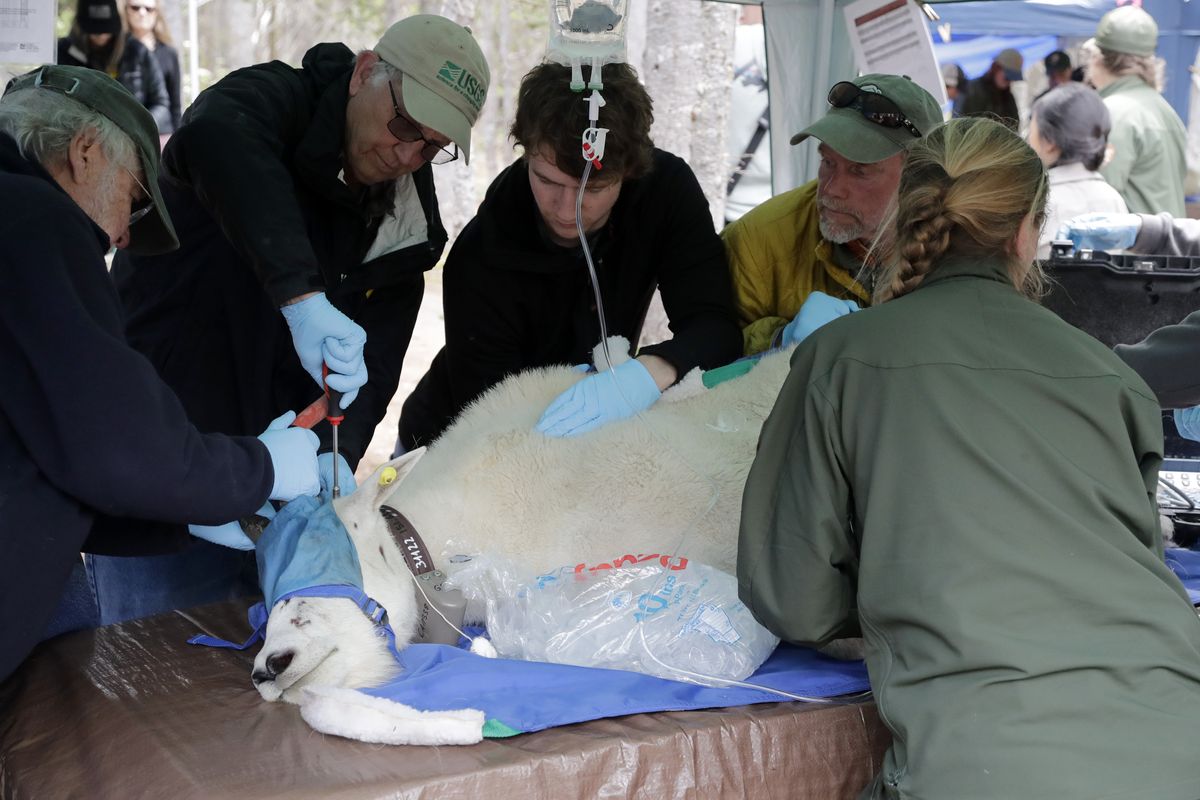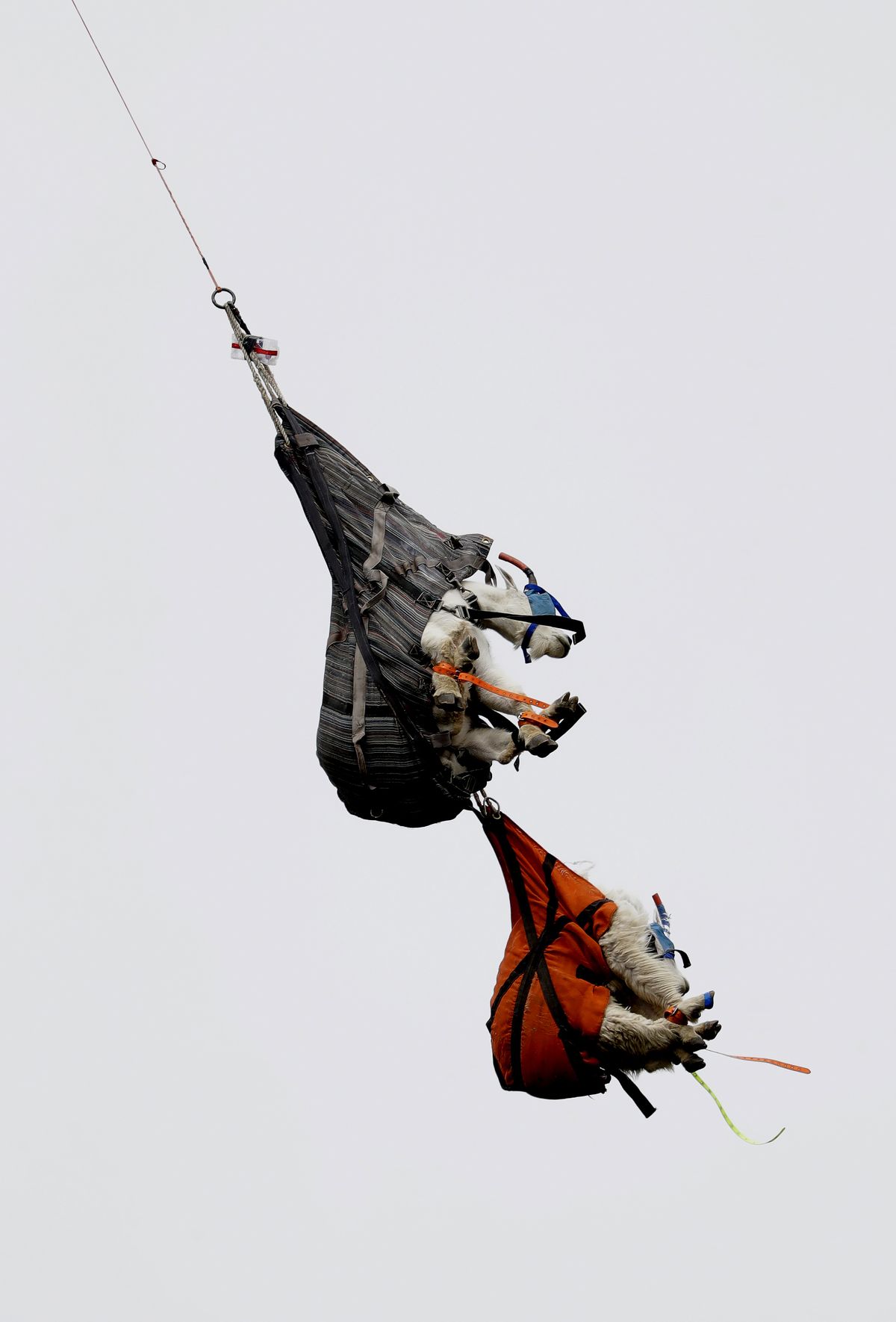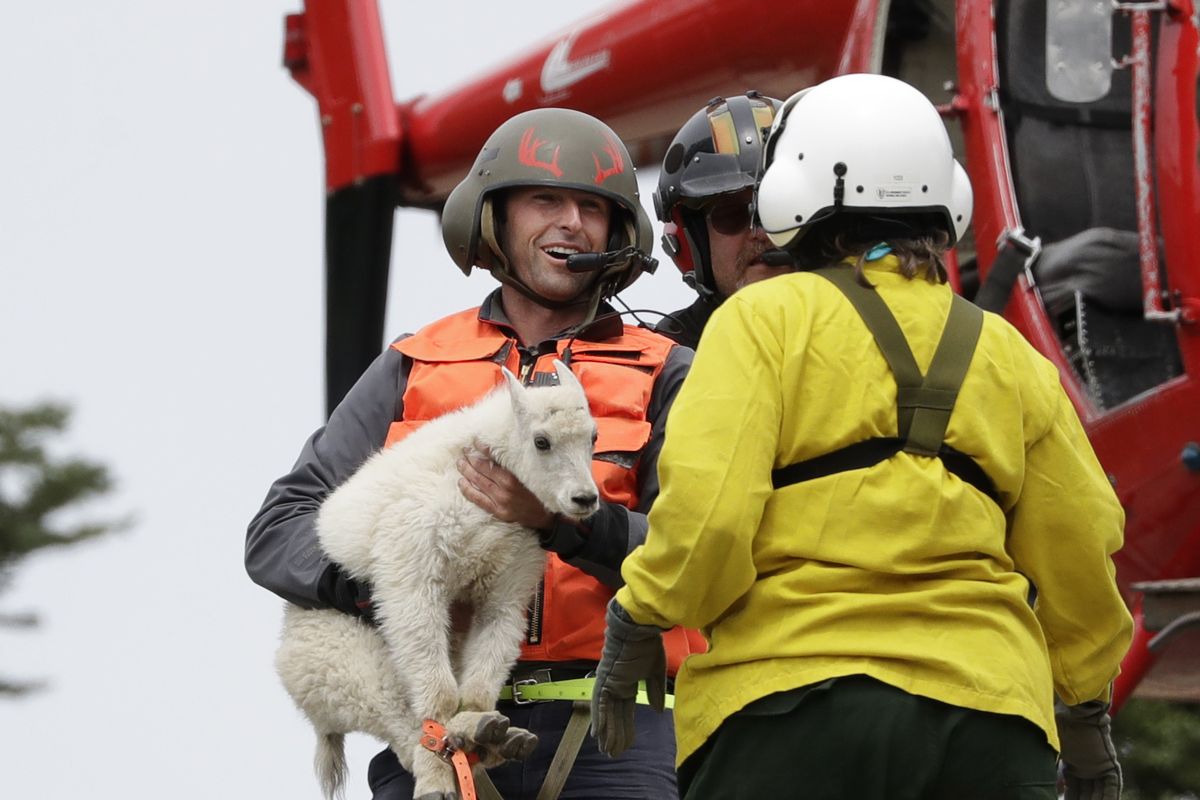Agencies in final stage of translocating mountain goats from Olympics to Cascades
Derrick Halsey, a wildlife capture specialist known as a “mugger,” hands off a kid mountain goat to Olympic National Park Wildlife Branch Chief Patti Happe on July 9 after airlifting the goat and two others to Hurricane Ridge in the park near Port Angeles, Wash. Officials last month began rounding up the sure-footed but nonnative mammals from remote, rugged parts of the park so they can be relocated into the Cascade Mountains, where they do belong. (Elaine Thompson/AP)
Starting July 27, a coalition of state and federal agencies, with support from local tribes, began the fourth and final two-week round of translocating mountain goats from Olympic National Park and Olympic National Forest to the northern Cascade Mountains to meet wildlife management goals in all three areas.
Once the translocation is complete, lethal removal of the nonnative species will begin later in the fall.
According to the National Park Service, since September 2018, 275 mountain goats have been translocated.
This effort is a partnership between the NPS, the Washington Department of Fish & Wildlife, and the USDA Forest Service to reestablish and assist in connecting depleted populations of mountain goats in the Washington Cascades while also removing nonnative goats from the Olympic Mountains. Mountain goats were introduced to the Olympics in the 1920s.
WDFW plans to release the mountain goats at 12 sites in the North Cascades national forests this round. Nine sites are in the Darrington, Preacher Mountain, Mt. Loop Highway, and Snoqualmie Pass areas of the Mt. Baker-Snoqualmie National Forest. Three release sites are in the Chikamin Ridge, Box Canyon, and Tower Mountain areas of Okanogan-Wenatchee National Forest.
“A project of this magnitude would be impossible without our partner agencies and the expertise and cooperation of hundreds of people,” said Olympic National Park Wildlife Branch Chief Dr. Patti Happe. “Because of this expertise and cooperation throughout the project, we anticipate reaching our objectives for capture and translocation in this final round.”
At the start of the translocation effort in 2018, the population of mountain goats was estimated at 725. Based on past removal efforts, it was estimated that approximately 50% of the mountain goat population, or 325-375 animals, could be safely captured over a total of four two-week periods. To date, 326 goats have been removed from the population on the Olympic Peninsula.
Lethal removal will begin after this final round of capture and translocation. The program will occur from Sept. 9-Oct. 17.
The National Park Service received more than 1,200 applications from groups of three to six participants to take part in the lethal removal process. From that collection, 21 groups were chosen to participate.
The selected volunteers will be required to navigate through park wilderness in difficult and steep terrain.
Participants must attend one day of training at the beginning of each designated removal session, pass a background check and meet requirements for physical fitness, orienteering, and experience recreating in extensive mountainous wilderness.
Groups may consist of field support personnel and expert shooters; only those who pass a firearms proficiency test (which will be administered during each training) will be permitted to shoot goats in the park. Each group must have at least one person that passes the proficiency test.
Volunteers must supply all their own required equipment and supplies, including suitable firearms and nonlead ammunition.
Trail impacts and road closures
The staging area for the mountain goat capture operation is located beyond the Hurricane Ridge Visitor Center in Olympic National Park along Hurricane Hill Road and is closed to public access.
Hurricane Hill Road is closed completely beyond the Hurricane Ridge Visitor Center through Aug. 9 for mobilization, capture operations, and demobilization. This closure includes the Hurricane Hill Trail, Little River Trail, and Wolf Creek Trail. Hurricane Ridge Road and all other area trails remain open.
A map of the area trails is available on the project website at nps.gov/olym/planyourvisit/mountain-goat-capture-and-translocation.htm.
No other closures will be in place for this project in Olympic National Park or the national forests.
Project background
In May 2018, the NPS released the final Mountain Goat Management Plan which outlined the effort to remove mountain goats on the Olympic Peninsula. Both the plan and the associated environmental impact statement were finalized after an extensive public review process which began in 2014.
“The mountain goat relocations not only augment resident populations, increasing population viability, but tracking the collared goats assists with our understanding of goats use of the habitat within the North Cascades” said Phyllis Reed, USFS Wildlife Biologist.
While some mountain goat populations in the north Cascades have recovered since the 1990s, the species is still absent from many areas of its historic range.
Aerial capture operations are conducted through a contract with Leading Edge Aviation, a private company that specializes in the capture and transport of wild animals. The helicopter crew uses immobilizing darts and net guns to capture mountain goats and transport them in specially made slings to the staging areas.
The animals are cared for by veterinarians before WDFW wildlife managers transport them to staging areas in the north Cascades for release. To maximize success, goats are airlifted in their crates by helicopter directly to alpine habitats that have been selected for characteristics.
Mountain goats follow and approach hikers because they are attracted to the salt from their sweat, urine and food. “The north Cascades is a vast landscape, that is less population-dense than Olympic National Park,” said Will Moore, a WDFW wildlife manager who specializes in mountain goats.
“We also know that the Cascades have natural salt licks, that mountain goats depend on,” added Moore. “Because of this, they won’t rely as much on humans to provide their salt fix.”
Area tribes that have supported the translocation plan in the Cascades include the Lummi, Muckleshoot, Sauk-Suiattle, Stillaguamish, Suquamish, Swinomish, Tulalip, and Upper Skagit tribes. Volunteers from the Lower Elwha Klallam Tribe, Point No Point Treaty Council, Quileute Tribe, Quinault Indian Nation, Skokomish Indian Tribe, and Port Gamble S’Klallam Tribe have assisted with past operations at the staging areas in the Olympics.


